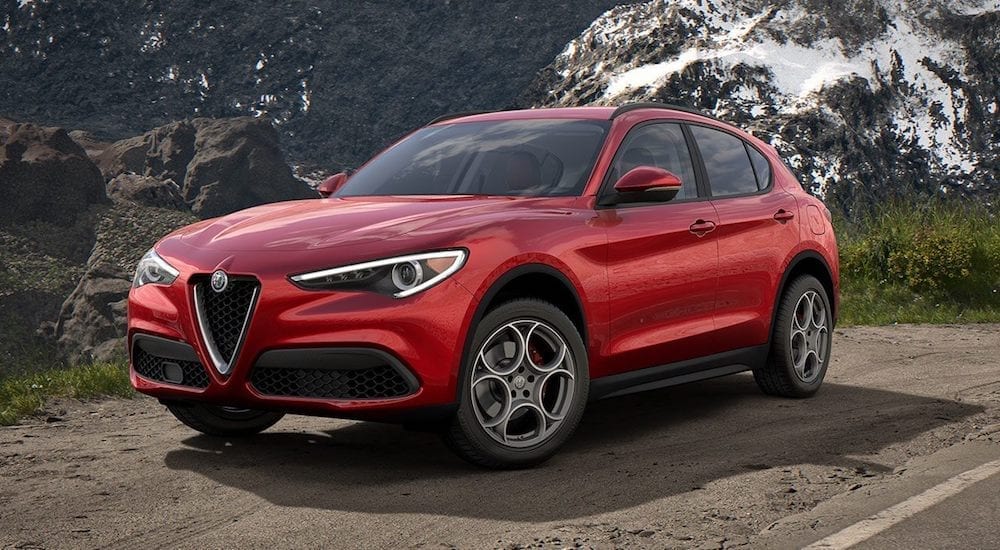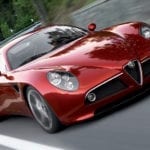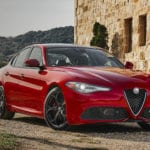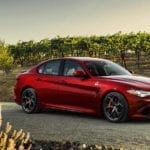Some cars seem to suffer from an identity crisis, unsure of what it’s supposed to be. Take the 2018 Alfa Romeo Stelvio – Albany, NY ’s favorite solution to the age-old question of how you turn a boring crossover into a conversation piece. All jokes aside, we’re not picking on Albany (it just happens to be first on our alphabetical map of the U.S.A.) However, depending on our findings, we may be picking on the Stelvio, a bit.
The Naysayer
There are combinations that just don’t feel like a natural fit with one another. The equivalent of an expectant mother making demands for peanut butter and pickles comes to mind, but the automotive equivalent that instantly springs to mind is the combination of Italian performance & SUV.
Perhaps I’m jaded by my personal disregard for crossover and SUV styling in general, but it just feels so limited by the expectations placed upon it. First of all, designers need to focus on the two primary directives: the accommodation of passengers and/or cargo. Right off the bat, this forces all models down one of two roads (i) truck-styling, or (ii) wagon-styling. And just when you think it can’t get any more generic, the mindset of accommodating all kinds of passengers ignites a kitchen-sink mentality. Infotainment technology is shoe-horned in, seating is proportioned and positioned in the manner deemed most suitable to maximize the space, and safety features are added (offsetting the inevitable existence of driver blind spots). There’s little way around it: crossovers and SUV styling is limited by the expectations placed upon it.
So what can be expected of an SUV engineered by a performance-driven, amenity minimalist like Alfa Romeo? Chances are it won’t feel entirely Alfa, or entirely SUV. But if it lacks white-knuckle performance and offers little utilitarian value, what’s left? The Styling? And if so, what separates it from the likes of the Audi Q5, BMW X3, and Jaguar F-Pace? Frankly, is it even a result that’s even worth exploring?
The Short Answer?
Yes, of course, it’s worth exploring. Following the infamous famine of new Alfa offerings making their way to the states, and the celebrated re-introduction of the Giulia, the Stelvio was bound to rouse some enthusiastic anticipation.
But it had its work cut out for it, from the get-go. At the Ti Lusso trim level, the going price for a Stelvio falls somewhere in the vicinity of $55,000. Considering it is (in many ways) out-classed by the previously-named competitors, boasting a price tag that’s nearly $15,000 higher isn’t doing the Stelvio any favors.
But for those that truly love Alfa, such comparison won’t matter. With that in mind, and in the language of the motherland, let’s get to ‘al punto’ and see what the Stelvio is made of.
Getting to Know the Stelvio
First off, the overall look of the Stelvio stands out in giving a sportier look to a wagon-inspired styling. While it may be appealing to some, the truth is that almost cheapens the distinctive front fascia and Alfa badging. At the risk of sounding glib, you could cover the front-end with a blanket and tell me it was a new concept CX-5 and I might be inclined to believe you.
The AWD Stelvio is powered by a turbocharged 2.0-liter inline four-cylinder engine mated to an eight-speed automatic transmission. If we’re judging the Stelvio on its own merit, it makes a respectable first showing. Cranking out 280 horsepower and 306 lb-ft of torque, its no weakling. It is, however, worth noting that the (yet-to-be-released) Quadrifoglio trim is spec’d to run a twin-turbo 2.9-liter V6. At 505 hp and 443 lb-ft, it makes for a far more enticing offering.
To that point, let’s back-pedal to the trims. The Stelvio follows Alfa’s three-faceted model of a base offering, followed by a Ti and the all-in Quadrifoglio. While such distinction makes for an appealing look at a performance sedan like the Giulia, it just feels uninteresting in a crossover. Sure, I’d rather drive the Ti than the Base, and I’d rather drive the Quadrifoglio than the Ti, but we’re really splitting hairs in any comparison.
The cabin design is clearly driver-centric, as would be expected of an Alfa. But while this is excusable in a design like the Giulia, it feels counterintuitive in a crossover. One would expect more passenger comfort, and in that regard, they can expect to be disappointed.
As mentioned earlier, Alfa is well known for being minimalists in terms of amenities. Favoring styling and strong material choices as the focal point of cabin design, technology takes a back seat. By the standards of today’s drivers, that would normally be considered a negative but Alfa excels at spinning it as a positive; an idiosyncratic nuance of the Alfa Romeo experience. That said, it would feel like a more impressive choice if the Stelvio’s controls didn’t feel so…FCA. A minimalist approach would be easy to embrace if strong stylistic choices were made, but in this case, Alfa fails to serve up either.
But the Stelvio does offer a smooth, powerful and confident ride, engaging the driver. So that’s a plus.
Final Thoughts
While the Stelvio requires no advocate, it is genuinely challenging to endorse it as anything other than a niche offering. While conceived effectively as an ‘on-brand’ crossover, the normal cache of an Alfa Romeo seems diminished by the overall uncertainty of the Stelvio’s final rendering. And its effectiveness as a crossover feels short-changed as a result of its desire to be something sporty, and high-end.
What’s left is a middling, undecided offering whose appeal depends heavily on its badging. Personally, I’d rather drive off in a Q5 and pocket the difference, but that’s just me. On the other hand, I tend to be a fan of Alfa, so maybe my lack of interest in the Stelvio speaks volumes.




